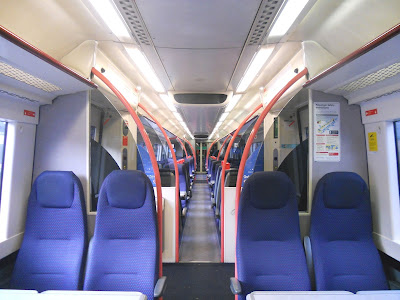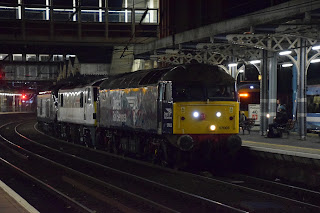Peter Skuce Reports (6A)
 |
| Chiltern 168. (C) P Skuce. |
During the 1960s British Railways built forty one, 4 carriage Class 115 DMU trains for the London Marylebone – Aylesbury Chiltern Line. One trailer carriage had entirely Standard Class accommodation with 106 seats, whilst the other trailer carriage was a composite, featuring First Class cabins with seating to the 2+2 layout and Standard Class with two toilets. They were powered by Leyland Albion engines, with mechanical transmission and their maximum speed was 70 mph. A new maintenance depot was built at Aylesbury to accommodate the trains.
Between Harrow on The Hill and Amersham, the Chiltern Line shares its tracks with the Metropolitan Line, which commences from Aldgate and Baker Street.
The London Marylebone – Aylesbury Chiltern Line is on the former Great Central Main Line and the line beyond Aylesbury to Leicester, Loughborough, Nottingham and Sheffield closed in 1966.
When Network SouthEast was created in June 1986, plans were made to modernise the line with rebuilt stations (a budget of £10 million was set aside for stations alone), rebuilt platforms, improved customer information with VDU screens plus digital clocks, replacement of semaphore signals with colour light signals and a fleet of thirty nine Class 165 Chiltern Turbo DMU trains, which were built in 1990 - 91. There are twenty eight 2 carriage Class 165 and eleven 3 carriage Class 165 all fitted with a Perkins 2006-TWH engine with a maximum speed of 75 mph. Each train had a Driving Motor Composite with a First Class cabin with sixteen seats followed by Standard Class accommodation sixty six seats and a Driving Motor Standard vehicle had 98 seats, all in Standard Class.
Eleven of the Class 165 feature an additional vehicle in the form of a Motor Standard Open vehicle of the eleven 3 carriage sets has 106 seats. This vehicle is between both the DMCO and DMSO vehicles. Class 165 bought the end of guards being employed on board trains to ensure doors were closed and giving the starting signal to the driver, as the trains are Driver Only Operation (DOO for short). The depot at Aylesbury was modernised and upgraded to deal with the new trains.
London Marylebone and Aylesbury were extensively refurbished into Network SouthEast colours of red, blue and white.
The Class 165 DMU trains work the following suburban services:
* London Marylebone – Harrow on The Hill – Amersham – Aylesbury
* London Marylebone – Denham – High Wycombe/Banbury
* London Marylebone – Denham – Princes Risborough - Aylesbury
These major enhancements/improvements sparked a gradual increase in passenger usage and the Chiltern Lines became known for it’s ‘Cinderella rags to riches’ story and improvements were to keep on coming.
Upon privatisation in the mid 1990s, the management of Network SouthEast bought Chiltern Lines and later on renamed it Chiltern Railways. They soon went onto remove First Class from their trains, so all trains became Standard Class only.
The company was the first to order brand new trains, since privatisation and they were five 3 carriage length ADtranz Class 168 Clubman Turbo DMU trains, built specifically for the prestigious London Marylebone – Banbury – Leamington Spa – Birmingham Moor Street/Stratford Upon Avon routes. They were delivered in 1998 and the Class 168 Clubman DMU fleet has been expanded since then in batches until 2004. All Class 168 Clubman DMU trains have a maximum speed of 100 mph, which is required for the London Marylebone – Birmingham Moor Street/Stratford Upon Avon express services.
Peter. More In Part 4B on the 15th.







